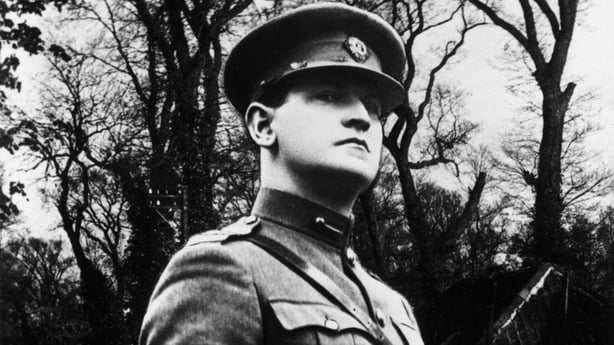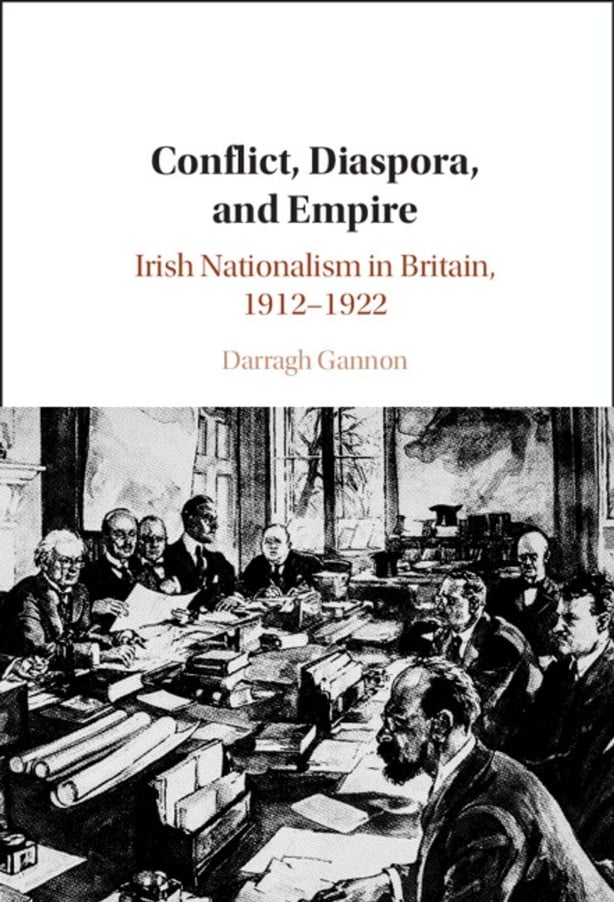After the Decade of Centenaries - ten years of intensively studying the events of a century ago - is there a single new thing to be said about the period from the Third Home Rule Bill to the Treaty?
Well, yes, actually.
Conflict, Diaspora & Empire, academic and author Darragh Gannon's new study of Irish nationalism in Britain from 1912 to 1922 offers interesting, sometimes provocative, new insights into the Home Rule and Independence movements, and in particular the often-underestimated impact on events in this island of Irish nationalism in Britain.
As the author acknowledges, Irish nationalism in Britain is often seen as marginal, as a sideshow, to the main action in Ireland itself; but he argues persuasively that for Home Rule activists, for Sinn Féin propagandists, and for IRA guerrillas, Britain was actually a crucial theatre of operations, that in many ways "the Irish Revolution was defined by political conflicts, and cultures, across the Irish Sea".
It was, of course, the parliamentary arithmetic at Westminster, and the reduction of the power of the House of Lords after the battle over Lloyd George’s 'People’s Budget’ in 1909, that made new Home Rule legislation in 1912 both possible and inevitable.
But those developments didn’t make Home Rule popular with British voters, who were more interested in other issues. When they did think of Ireland, they tended to think of nationalists as "disloyal", and to oppose coercion to force Ulster Unionists under a Home Rule parliament in Dublin. This forced the Irish Party to appeal to a British as well as an Irish audience, giving rise to what Gannon terms ‘the "two faces" of Home Rule’
The dispute between unionism and nationalism was very visible on British streets, with the formation of the Ulster and Irish Volunteers leading to uniformed (and sometimes armed) formations marching through city streets on the ‘mainland’, with the consequent threat that the two groups could come to blows in Britain as well as in Ireland. The Ulster Unionist Northern Whig newspaper sourly remarked that ‘to bring civil war to our loyal, peaceful and prosperous province may appear a slight matter to Mr Asquith and Mr Birrell but are they also prepared to face it in Glasgow, in Liverpool, and in other parts of Lancashire?’
The outbreak of war in 1914 defused that particular threat, but it raised other problems.
Redmond expected a short war, to be followed in 1915 by a General Election at which the terms of Home Rule – and in particular the question of exclusion for part of the north east – would be an issue.
Hence the necessity to stress the patriotism of Home Rulers, and to encourage Irish enlistment in the British Army. Estimates suggest that by the spring of 1915, 115,000 Irishmen in Britain had enlisted, a record on which Redmond hoped to base a claim for political concessions after the war.
The ‘two faces’ of Home Rule became a problem with two subsequent developments: Redmond’s refusal of a Cabinet post in 1915, which was popular in Ireland but not among the Irish in Britain; and the threat of conscription in Ireland, which Redmond opposed due to its unpopularity among his Irish supporters, but which the Irish in Britain saw differently.
Irish Party MP T.P. O’Connor - Irish-born, but elected from a constituency in Liverpool – felt opposition to conscription damaged the Home Rule case among British voters. He wrote in November 1915: ‘It looks to me at the moment as if the alternative of the Irish Party was to lose Ireland or to lose England... either we have some compulsion [conscription] or lose the War; and the loss of the War is the end of all things.’
The end of the war also saw the end of the Irish Party, eclipsed by the rise of Sinn Féin, and of its subsidiary in Britain, the Irish Self-Determination League (ISDL).

The new organisation was a disappointment when it came to fundraising, raising just £6,000 for Dáil Bonds. Michael Collins complained bitterly that ‘it is an extraordinary thing how badly the Irish in Great Britain have done in this particular effort. Imagine, one remote mountainous constituency [in Ireland] supplying as much money as all the Irish in Great Britain. It is a most eloquent commentary on how they forget.’
But while the response to appeals for financial support was disappointing, the Irish in Britain did respond to repression in Ireland, coming out in their thousands to protest at the Black and Tans, and to line the streets of London for Terence MacSwiney’s funeral.
However, there was criticism in Dublin of the ISDL’s failure to adequately mobilise non-Irish opinion in Britain – Erskine Childers (himself London born) pointed out that ‘the ISDL themselves don’t need to be convinced and the other 43 millions do’. This argument against preaching to the converted was, of course, precisely the calculation that Redmond had made.
A far more important contribution to the independence struggle was through arms smuggling, which was centred on the IRB based in Britain. Under the direction of Michael Collins, Gannon argues that the operation was highly efficient and specialised to suit the strengths of different areas - the organisation in the Liverpool docks looking after transport to Ireland, for instance, rather than also using other ports where the IRB was weaker. This made the IRB in Britain central to the delivery of war material – and, consequently, to the prosecution of Collins’ part of the war.
The IRA also launched ‘operations’ in Britain, including the burning of timber yards and warehouses in Liverpool and London, which caused considerable damage. While the historiography of the War of Independence tends to see these as secondary to the main actions in Ireland, Gannon perceptively notes that this wasn’t how they were seen at the time in Britain, where newspaper coverage gave them far more prominence. Indeed, three separate Cabinet meetings between November 21st and December 5th 1920 focussed on the supposed IRA threat in Britain, far more political attention than was paid to Bloody Sunday or Kilmichael.
IRA units also attacked the London and Liverpool homes of members of the Auxiliary Division – 16 such attacks were carried out on Saturday May 14th, 1921 – reprisals for reprisals which again attracted much attention. The following month, communications in Britain – telephone and telegraph lines, and rail networks – were attacked on the orders of IRA GHQ.
These operations in Britain may have had more of an influence on British peace moves than better-known events at home. As later generations of republican militarists would learn, the British public, media and political establishment paid far more attention to actions in Britain than to those on the island of Ireland.
Conversely, British action against the IRB arms smuggling network which reduced the flow of guns across the Irish Sea was one of the key factors convincing Collins that the IRA’s war was not sustainable.
In other words, Gannon’s narrative suggests, it was events in Britain that convinced both sides that a Truce was in their best interests in July 1921, and that subsequently led Collins to accept the Treaty rather than return to war.
Gannon argues that there were two distinctive nationalist cultures in the decade, "British-Ireland" and "Irish-Ireland", the former represented by the Irish Party, the latter by Sinn Féin. The story told in the book suggests that the former failed to hold Irish opinion, while the latter failed to sufficiently influence British opinion. Had it done so, it might have made greater concessions possible in the eventual Treaty settlement, perhaps enough to make it satisfactory to a broader swathe of opinion at home and to avoid Civil War. But the logic of separatism was that it removed Ireland from the central position in British politics it had occupied a decade before; British public opinion, and British politicians, were perfectly content to subsequently forget that there was such a thing as an Irish question, far less to have to consider what the answer might be.
Darragh Gannon has written a persuasive book, which strongly suggests that accounts of the revolutionary decade which treat events in Britain as marginal, are actually looking through the wrong end of the telescope; the successes and failures of Irish nationalists in Britain had an important impact on events between 1912 and 1922. This book deserves to be widely read, and while its price as an academic publication might put off the general reader, hopefully local libraries will be able to make it readily available.

Conflict, Diaspora and Empire: Irish Nationalism in Britain, 1912-1922 is published by Cambridge University Press - find out more here.


